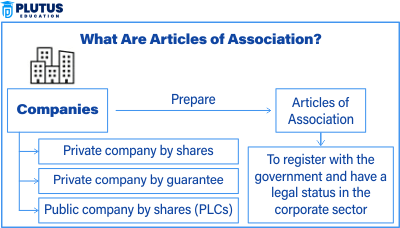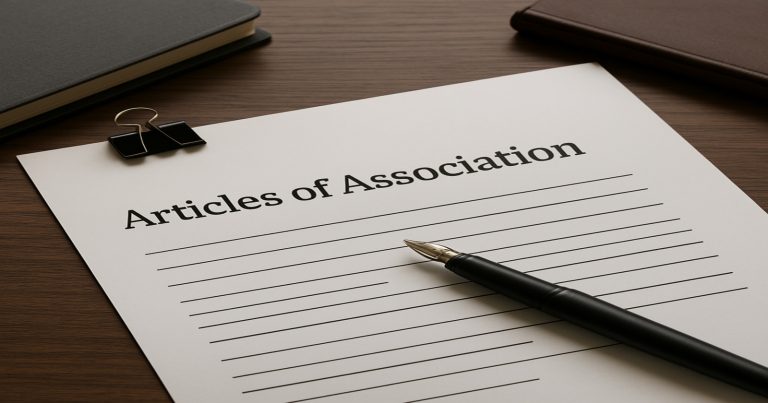The Articles of Association form the rules and regulations governing internal business of the company. These cover the powers and responsibilities that an investor (or individual or party that invests) has at its shareholders and as a host of other disguises as well as directors. The complementary yet legally binding document is a framework for governance capitalism together with the Association Memorandum. We will examine a wide aspect as applied in the article related to the Articles of Association.
What is AOA?
An article of association is a written document containing the internal rules to govern a company. It provides provisions about the management of the company, including the conduct of meetings, powers of directors, shareholder rights, and many more. Articles are significant because they set out how the company will function daily.
The legal implication of the Articles of Association is that they constitute a contract between the company and the shareholders. They impose the rules of the company on the company and each shareholder. They also determine how shares may be allotted or transferred, dividends declared, and capital further subscribed. The Articles of Association can be considered to complement the Memorandum of Association in the constitution of the company.
AOA Full Form
The full form of AOA is the Articles of Association. It is one of the fundamental documents that need to be constituted to operate a company legally. AOA works hand in hand with the Memorandum of Association and collectively helps to define and further explain the general structure of a company and how it will function.
Objectives of the Articles of Association
The Articles of Association primarily aim to give a general outline of how a company is going to be run. The following are the specific objectives:
- Regulation of Internal Management: The rules guiding how the company would be run in their day-to-day activities, who the directors should be appointed or removed by, and in what ways and procedures they are to be ascertained.
- Shareholder Rights: The AOA provides information on the rights of shareholders, such as voting rights, rights to dividends, and how disputes between shareholders are settled.
- Director’s Powers and Liabilities: It outlines what powers the Board of Directors possesses, among which is the capacity to manage a company’s resources, raise shares, and make financial decisions.
- General and Board Meetings: The AOA provides procedures for conducting a general and board meeting, including how votes are cast, quorum requirements, and the conduct of a meeting.
- Share Issuance and Transfer: The document specifies how new shares can be issued and the procedures governing the transfer and sale of shares within the company.
The Articles of Association in essence are the company’s norms of governance allowing all parties to know their respective roles and responsibilities.

Forms of Articles of Association (AOA)
Different types of articles of association exist depending on the company structure. Below are the most common forms:
1. Model Articles
By making use of such standardized Model Articles as those given by governing bodies such as the UK Companies Act 2006, even businesses that do not care to create their own articles will be able to stand on a firm legal footing.These model articles can also be used as an effective tool to rapidly comply with international conventions and other requirements. The gaming activities of a second company support its development into mid-scale mixed cultural construction factories, while the listing of another company’s games here is just a general description.With such model articles, they may play their role well for small and middle scale enterprises, thus achieving the minimum formalization needed.
2. Customized Articles
Larger organizations or businesses usually have their own bespoke articles of association because their operational needs may be unique. Thus, depending on the company’s needs, there could be unique provisions that may not exist in the model articles.
3. Table A
Table A provides to companies created under earlier legislation, like the Companies Act 1985 of the UK, a form of basic template articles of association. Most pre-2006 companies continue using this version unless they apply the model articles.
4. Non-profit Articles
Besides, special articles of association can be employed by non-profit organizations. These identify the objects or charitable purposes and detail how their assets are to be applied for the public good. The provisions normally exclude dividends to members or shareholders.
Difference Between AOA and MOA
Although the Articles of Association and the Memorandum of Association are both foundational documents, they serve different purposes within a company’s structure.
| Criteria | Memorandum of Association | Articles of Association |
|---|---|---|
| Purpose | Defines the external relationship of the company with outsiders and the scope of activities it can undertake. | Governs the internal management of the company, including shareholder rights and director powers. |
| Legal Binding | It is a public document, binding on the company and the external parties interacting with it. | It acts as an internal document, binding the company, its shareholders, and directors. |
| Amendments | Harder to amend, requires special resolution and, in some cases, approval from authorities. | Easier to amend, with provisions within the articles to allow adjustments by shareholder vote. |
| Content | Includes the company’s name, objectives, registered office, liability of members, capital structure, and founding shareholders. | Includes detailed operational rules such as meeting procedures, the appointment of directors, the issue of shares, and dividend policies. |
The Memorandum serves as the company’s charter, outlining its broad operational goals, while the Articles of Association provide the detailed framework for day-to-day governance.
Conclusion
In conclusion, the Articles of Association are indispensable for regulating a company’s internal affairs. They ensure that every action taken by the company, whether by directors, shareholders, or other officers, adheres to a predetermined set of rules. This document plays a crucial role in the smooth operation of the company and provides clear guidelines on governance, decision-making, and shareholder rights. By maintaining a clear set of articles, companies can avoid internal disputes and ensure that their operations remain compliant with corporate laws.
Articles of Association FAQs
What is AOA full form?
The full form of AOA is Articles of Association, a document that outlines the internal rules and regulations governing a company’s operations and management.
What is MOA and AOA in a company?
The Memorandum of Association (MOA) and Articles of Association (AOA) define a company’s scope of work, objectives, rules and internal management. The MOA and AOA are two essential documents that are the basis of the company’s constitution. They are indispensable, and the company’s foundation stands upon them.
Is it mandatory to have Articles of Association?
Yes, every registered company must have Articles of Association.
What is the difference between AOA and MOA?
The AOA (Articles of Association) govern internal management, while the MOA (Memorandum of Association) outlines the company’s relationship with the outside world.
What is the salary of AOA?
The average AOA salary ranges from approximately ₹10,99,786 per year (estimate) for a senior credit analyst to ₹11,00,105 per year (estimate) for a senior credit analyst. AOA employees rate the overall compensation and benefits package.
How do Articles of Association help in corporate governance?
The AOA provides the framework for governance, detailing the roles, responsibilities, and rights of directors and shareholders.


